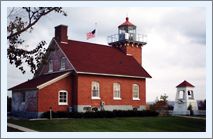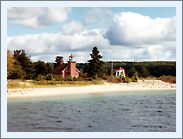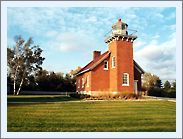|
Historical
Information

For centuries the area around Little Traverse Bay had been the home of
Ottawa Indians. Around 1700, French Jesuits arrived in the area and
constructed a mission at the famous L'Arbre Croche village, a huge
native village which stretched from Cross Village to Harbor Springs.
Dependant on agriculture, fishing and trapping in 1847, the village of
L'Arbre Croche was home to the largest concentration of natives people
in what would become the state of Michigan.
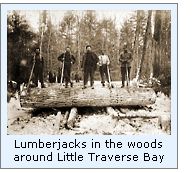 With the Richard Cooper's establishment of his store in 1853, a few
white settlers began to move into the area, however in accordance with
treaty agreements made in Detroit in 1855, the native people continued
to hold most of the prime land around the bay. With beginning
exploitation of the rich forest resources surrounding the bay, the
Michigan Legislature passed a resolution requesting federal funding of
harbor improvements in Little Traverse Bay, and the erection of a
lighthouse to guide vessels around the point which protruded into the
northern arm of the bay. With the Richard Cooper's establishment of his store in 1853, a few
white settlers began to move into the area, however in accordance with
treaty agreements made in Detroit in 1855, the native people continued
to hold most of the prime land around the bay. With beginning
exploitation of the rich forest resources surrounding the bay, the
Michigan Legislature passed a resolution requesting federal funding of
harbor improvements in Little Traverse Bay, and the erection of a
lighthouse to guide vessels around the point which protruded into the
northern arm of the bay.
After simultaneous memorials were presented in the Senate and House
on March 13, 1871, the matter was referred to the Commerce Committee for
evaluation, with the Commerce Committee in turn forwarding the request
to Brevet Brigadier General Orlando M.
Poe, the Chief Engineer of the
Ninth District for his evaluation. In his report to the Commerce
Committee dated April 11, Poe observed that "By reference to the
tracing of the lake-survey detail chart of Little Traverse, enclosed
herewith Ö the relation of the harbor of Little Traverse to the
navigation of Lake Michigan can be readily seen and appreciated. The
harbor itself is excellent in every respect, easy of access, affording
good anchorage and a complete shelter from all winds. A Light-house of
the fifth-order, together with a Fog-bell of 600 pounds with Stevenís
striking apparatus, will make the harbor available. In addition to its
relation to the general commerce of Lake Michigan, the harbor has some
local importance. This is increasing, and, doubtless, will continue to
do so." Following-up on Poeís report, the Lighthouse Board
requested an appropriation for $15,000 in its annual report for 1873.
However, strapped for funds, Congress ignored the request. While the
Board reiterated its request for funding the following year, the matter
was soon dropped in favor of more important projects elsewhere
throughout the system.
As was frequently the case, treaties with the native Americans were
frequently and expeditiously "modified" after their original
signing, and with the passage of treaty limitations in 1875, the land
around Little Traverse Bay was opened-up for settlers, and the flood
gates opened. Harbor Springs was formally incorporated as a village in
1880. After the opening of land availability, land lookers moved through the
area, claiming huge tracts of forest for their respective companies,
with lumbering operations following quickly on their heels.
Simultaneously with this commercial boom, word of the beauty of the bay,
its sunsets, clean air, cool breezes and clear water spread throughout
the Midwest, and an ever increasing number of moneyed individuals, their
pockets bulging with the bounty of the industrialization of the southern
Michigan cities began pouring into the area, building summer cottages,
mansions and hotels.
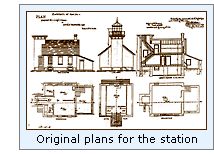 With this unprecedented boom in commercial and recreational activity,
there was a massive increase in vessel traffic in Little Traverse Bay,
and local interests again began petitioning for the construction of the
lighthouse recommended almost ten years previously. This time, the
response was more positive, with Congress approving the $15,000
appropriation for the establishment of a light at Little Traverse on
August 7, 1882. By the end of the year, plans for the new station had
been drawn up, and a survey team dispatched to identify the ideal
location for the new station. With this unprecedented boom in commercial and recreational activity,
there was a massive increase in vessel traffic in Little Traverse Bay,
and local interests again began petitioning for the construction of the
lighthouse recommended almost ten years previously. This time, the
response was more positive, with Congress approving the $15,000
appropriation for the establishment of a light at Little Traverse on
August 7, 1882. By the end of the year, plans for the new station had
been drawn up, and a survey team dispatched to identify the ideal
location for the new station.
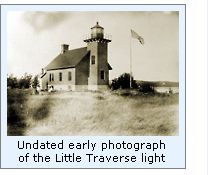 After obtaining clear title to the selected reservation early in
1884, a construction crew was delivered to Harbor Point on May 14, and
work at the site began in earnest. By June 30, the basement had been
excavated and the cut stone foundation walls laid. Joists for the first
floor had been installed and the brickwork carried up to a height of two
feet above the foundation level. The 1 ½-story brick dwelling stood 25í
by 37 feet in plan, with a 10í square tower standing 30 feet in height
integrated into its south gable end. The tower was capped by a square
copper-floored gallery with iron hand railings, centered on which an
octagonal cast iron lantern was installed. The District Lampist arrived
from Detroit and installed the stationís fixed red Fourth Order
Fresnel lens ordered from Sautter and Lemonier of Paris, France. 42-year
old Elizabeth Whitney Williams accepted a transfer from the St. James
Harbor lighthouse on Beaver Island where she had been serving for the
past twelve years. Construction was completed on September 18, and with
Elizabethís and her husband Danielís arrival, she climbed the stairs
of her new station and officially exhibited the new light on the evening
of September 25, 1884, sending the light 13 miles across the bay. After obtaining clear title to the selected reservation early in
1884, a construction crew was delivered to Harbor Point on May 14, and
work at the site began in earnest. By June 30, the basement had been
excavated and the cut stone foundation walls laid. Joists for the first
floor had been installed and the brickwork carried up to a height of two
feet above the foundation level. The 1 ½-story brick dwelling stood 25í
by 37 feet in plan, with a 10í square tower standing 30 feet in height
integrated into its south gable end. The tower was capped by a square
copper-floored gallery with iron hand railings, centered on which an
octagonal cast iron lantern was installed. The District Lampist arrived
from Detroit and installed the stationís fixed red Fourth Order
Fresnel lens ordered from Sautter and Lemonier of Paris, France. 42-year
old Elizabeth Whitney Williams accepted a transfer from the St. James
Harbor lighthouse on Beaver Island where she had been serving for the
past twelve years. Construction was completed on September 18, and with
Elizabethís and her husband Danielís arrival, she climbed the stairs
of her new station and officially exhibited the new light on the evening
of September 25, 1884, sending the light 13 miles across the bay.
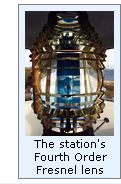 With the creation of the Twelfth Lighthouse District, which
encompassed all of Lake Michigan on July 25, 1886, a search was on for a
location for a buoy depot to serve the northern portion of the lake.
Identifying that the protection offered by Harbor Point represented a
perfect location for such an facility, the Board requested an
appropriation of $50.000 to purchase a site and erect the necessary
sheds and wharves at Little Traverse. However, this request was not
repeated in subsequent reports, and the buoy depot was eventually
established at Charlevoix. With the creation of the Twelfth Lighthouse District, which
encompassed all of Lake Michigan on July 25, 1886, a search was on for a
location for a buoy depot to serve the northern portion of the lake.
Identifying that the protection offered by Harbor Point represented a
perfect location for such an facility, the Board requested an
appropriation of $50.000 to purchase a site and erect the necessary
sheds and wharves at Little Traverse. However, this request was not
repeated in subsequent reports, and the buoy depot was eventually
established at Charlevoix.
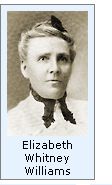 With increasing population, a municipal water supply was established
at Harbor Sprigs 1891, and the Twelfth District Engineer Major William
Ludlow took advantage of the availability of the supply of clean potable
water by having the station hooked-up to the system that same year.
Three years later, a summer kitchen was erected, a new woodshed was
constructed, the old woodshed converted into a barn for Mrs. Williamís
horse, and wooden sidewalks laid to connect all of the station
buildings. With increasing population, a municipal water supply was established
at Harbor Sprigs 1891, and the Twelfth District Engineer Major William
Ludlow took advantage of the availability of the supply of clean potable
water by having the station hooked-up to the system that same year.
Three years later, a summer kitchen was erected, a new woodshed was
constructed, the old woodshed converted into a barn for Mrs. Williamís
horse, and wooden sidewalks laid to connect all of the station
buildings.
To serve the growing number of pleasure boats transporting
vacationers in and out of the harbor in thick weather, a fog bell tower
was established on the point in front of the lighthouse on June 1, 1896.
Standing 18-feet tall at the eaves, the tower was divided into upper and
lower sections. The bell was suspended in the open upper section and a
Stevens automated bell striking apparatus located in the enclosed lower
section. Powered by a weight within a vertical wooden conduit, with its
cable wound around a drum on the mechanism, the weight was cranked to
the top of the conduit, and the drum rotated as the weight slowly fell
to the bottom of the conduit. The mechanisms within the Stevens
apparatus converted this rotary motion to a linear motion, which was
then transferred to a large hammer which struck the bell with two sharp
blows every 30 seconds.
I
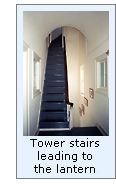 n the early days of the US lighthouse service, lard and sperm oil
ware used for fueling the lamps. Relatively non-volatile, the oil was
stored in special rooms in lighthouse cellars or in the dwelling itself.
With a change to the significantly more volatile kerosene, a number of
devastating dwelling fires were experienced, and beginning late in the
1880's the Lighthouse Board began building separate oil storage
buildings at all US light stations. To this end, a work crew and
materials were delivered at the station in 1898, and a brick oil storage
building was erected a safe distance from the main building. n the early days of the US lighthouse service, lard and sperm oil
ware used for fueling the lamps. Relatively non-volatile, the oil was
stored in special rooms in lighthouse cellars or in the dwelling itself.
With a change to the significantly more volatile kerosene, a number of
devastating dwelling fires were experienced, and beginning late in the
1880's the Lighthouse Board began building separate oil storage
buildings at all US light stations. To this end, a work crew and
materials were delivered at the station in 1898, and a brick oil storage
building was erected a safe distance from the main building.
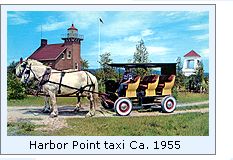 Other than the installation of a lightning rod on the tower the
following year, Elizabethís life at Little Traverse settled into a
peaceful routine for the next decade. While her husband Daniel
photographed the resort country around the bat, selling his images the
summer resort visitors, the relative peace and quiet afforded Elizabeth
the opportunity to write her recollections of childhood on Beaver Island
during the reign of King James Strang, and her life as keeper of the Stí
James Harbor lighthouse after the death of her first husband. At the
urging of friends, the 63-year old Elizabeth published her famous
autobiography "A Child of the Seaí in 1905, with Elizabethís
memoirs bringing considerable admiration, as people learned of her
interesting and trying life story. After 43 years of lighthouse service,
Elizabeth retired in 1913, and she and Daniel retired in Charlevoix,
where she had spent her winters during her years tending the Beaver
Harbor light. Other than the installation of a lightning rod on the tower the
following year, Elizabethís life at Little Traverse settled into a
peaceful routine for the next decade. While her husband Daniel
photographed the resort country around the bat, selling his images the
summer resort visitors, the relative peace and quiet afforded Elizabeth
the opportunity to write her recollections of childhood on Beaver Island
during the reign of King James Strang, and her life as keeper of the Stí
James Harbor lighthouse after the death of her first husband. At the
urging of friends, the 63-year old Elizabeth published her famous
autobiography "A Child of the Seaí in 1905, with Elizabethís
memoirs bringing considerable admiration, as people learned of her
interesting and trying life story. After 43 years of lighthouse service,
Elizabeth retired in 1913, and she and Daniel retired in Charlevoix,
where she had spent her winters during her years tending the Beaver
Harbor light.
On November 3, 1913, Alfred Erickson accepted a transfer from the
Calumet Pierhead Light where he had been serving as Keeper for the past
two years. A young man of twenty-six, Ericson had entered lighthouse
service at the age of seventeen, with his first assignment being as
Second Assistant at Plum
Island, before serving at Chicago Harbor and
Sheboygan Pierhead stations before accepting his transfer to Calumet in
1911.
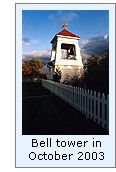 Other than a change in the characteristic of the fog bell from a
double stroke every 30 seconds to a single stroke every 30 seconds in
1914, Ericsonís life settled into the same quite routine as Elizabethís
before him, and he continued to enjoy duty at Little Traverse until he
resigned from service in 1940, the year after President Roosevelt
transferred responsibility for the nationís aids to navigation to the
Coast Guard in 1939. With this transfer, the old "Wickies"
were given the option of continuing as civilians, or transferring into
the Coast Guard. Many of the old civilian keepers could not stand the
mountains of paperwork resulting from the Coast Guard takeover, and
since Ericson was only 53 years of age, it is likely that he found other
work in the area. With the Coast Guard takeover, the characteristic of
the light was changed from fixed red to fixed green. Other than a change in the characteristic of the fog bell from a
double stroke every 30 seconds to a single stroke every 30 seconds in
1914, Ericsonís life settled into the same quite routine as Elizabethís
before him, and he continued to enjoy duty at Little Traverse until he
resigned from service in 1940, the year after President Roosevelt
transferred responsibility for the nationís aids to navigation to the
Coast Guard in 1939. With this transfer, the old "Wickies"
were given the option of continuing as civilians, or transferring into
the Coast Guard. Many of the old civilian keepers could not stand the
mountains of paperwork resulting from the Coast Guard takeover, and
since Ericson was only 53 years of age, it is likely that he found other
work in the area. With the Coast Guard takeover, the characteristic of
the light was changed from fixed red to fixed green.
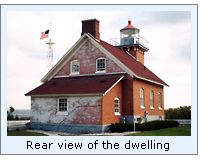 With improvements in RADAR and LORAN-C in the late 1950ís, the
vital role played by the old lighthouses and fog signals faded, and a
move was on to automate as many lights as possible in order to eliminate
the costs associated with full time crews at the stations. To this end,
a work crew arrived at Harbor Point in 1963 and erected a 41-foot tall
white-painted steel skeleton tower, outfitted with a flashing green
electric light. Standing at a focal plane of 72 feet, the new light was
visible for a distance of 14 miles. With improvements in RADAR and LORAN-C in the late 1950ís, the
vital role played by the old lighthouses and fog signals faded, and a
move was on to automate as many lights as possible in order to eliminate
the costs associated with full time crews at the stations. To this end,
a work crew arrived at Harbor Point in 1963 and erected a 41-foot tall
white-painted steel skeleton tower, outfitted with a flashing green
electric light. Standing at a focal plane of 72 feet, the new light was
visible for a distance of 14 miles.
The old lighthouse property was sold to the exclusive and gated
Harbor Springs community in which it was isolated, and remains under the
collective ownership of the community to this day. The grounds are
maintained in immaculate condition, and while no longer illuminated, the
Fourth Order Fresnel lens can still be seen sitting proudly within the
stationís lantern

Keepers of this Light

Click Here
to see a complete listing of
all Little Traverse Light keepers compiled by Phyllis L. Tag of Great
Lakes Lighthouse Research.

Finding this Light

Take US-31 to downtown Petoskey, and turn off at the entrance to the
municipal marina, where there are plenty of parking spaces. If you do
not have your own boat, the only way to obtain offshore views of the
station will be by hiring a charter fishing boat to take you out to the
Point.
Note that it is impossible to gain access to the
station from the land, as there is only one road leading out to the
Point, and it passes right through the guarded entrance to the gated
community of Harbor Point. 
Reference Sources
Journals of the US Senate
and House of Representatives, March 13, 1871
Annual reports of the Lighthouse Board, various, 1871 - 1909
Annual report of the Lake Carrier's Association, 1914
Little Traverse Lighthouse, pamphlet, Harbor Point Association
A look around Little Traverse Bay, Mary Candace Eaton, Little
Traverse Historical Society.
The Northern Lights, Charles K. Hyde, Ann & John Mahan, 1996
Personal observations at Harbor Point, 09/16/2000 |
